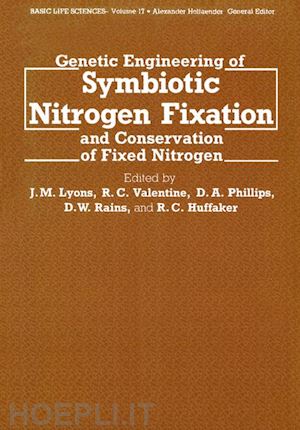I. Introduction.- Prefatory Chapter: Enhancing Biological Production of Ammonia From Atmospheric Nitrogen and Soil Nitrate.- Support of Problem Focused Nitrogen Fixation Research at the National Science Foundation.- Biological Nitrogen Fixation Research at the University of California, Davis.- II. Genetics and Regulation of Nitrogen Fixation.- A. Molecular Cloning of Nitrogen Fixation Genes.- Molecular Cloning of Nitrogen Fixation Genes from Rhizobium meliloti.- Cloning DNA from Rhizobium meliloti Using a New Broad Host Range, Binary Vehicle System.- Molecular Cloning of Rhizobium japonicum DNA in E. coli and Identification of Nitrogen Fixation (Nif) Genes.- B. Genetics and Regulation of Nitrogen Fixation Genes.- The Identification, Location and Manipulation of Genes in Rhizobium.- The Role of Rhizobium Plasmids in Host Specificity.- “Redox Control” of Nitrogen Fixation: An Overview.- A Mutant of Rhizobium japonicum 110 with Elevated Nif Activity in Free-Living Culture.- C. Hydrogen Uptake and Energetics.- Detrimental and Beneficial Effects of Oxygen Exerted on Hydrogen-Oxidizing Bacteria.- Hydrogen Uptake (Hup) Plasmids: Characterization of Mutants and Regulation of the Expression of Hydrogenase.- Detection of Plasmids in Rhizobium japonicum.- Chemolithotrophy in Rhizobium.- Hydrogen Uptake (Hydrogenase) Activity of Rhizobium japonicum Strains Forming Nodules in Soybean Production Areas of the U.S.A.- D. Genetic Regulation of Stress Tolerance.- Proline Over-Production Enhances Nitrogenase Activity Under Osmotic Stress in Klebsiella pneumoniae.- Selection of Naturally Occurring Stress Tolerant Rhizobium.- III. Plant Factors Impacting Nitrogen Assimilation.- A. Measurements and Efficiency of N2 Fixation.- Evaluating Potentially Superior Rhizobium Strains inSoybeans.- Physiological Interactions Between Alaska Peas and Strains of Rhizobium leguminosarum That Differ in Plasmid-Like Genes.- Evaluating Elite Alfalfa Lines for N2-Fixation Under Field Conditions.- Successes and Problems Encountered While Breeding for Enhanced N2 Fixation in Alfalfa.- B. Photosynthesis and Nitrogen Utilization.- Biochemical Genetics of Ribulose Bisphosphate Carboxylase/Oxygenase: High Frequency Transfer and Chromosome Mobilization by Broad Host-Range R-Factors in CO2?Fixing Bacteria.- Photosynthetic Enzyme Regulation by the Ferredoxin/ Thioredoxin and the Ferralterin Mechanisms.- Regulation of Photosynthetic CO2 Fixation.- Hydrolysis of Ribulose-1, 5-Bisphosphate Carboxylase by Partially Purified Endoproteinases of Senescing Primary Barley Leaves.- The Relationship Between Ribulose Bisphosphate Carboxylase Concentration and Photosynthesis.- IV. Nitrogen Fixation by Nonlegumes.- Nitrogen Fixation by Cyanobacterial Heterocysts.- Photosynthate Limitation of Nitrogen Fixation in the Blue-Green Alga, Anabaena variabilis.- Physiological Studies on N2-Fixing Azolla.- Application of Azolla in Crop Production.- A New Woody Plant Which Fixes Nitrogen: Chamaebatia foliolosa (Rosaceae).- Soil Factors Limiting Nodulation and Nitrogen Fixation in Purshia.- V. Conservation of Fixed Nitrogen.- A. Denitrification.- Overview of Denitrification.- The Physiological Genetics of Denitrification in Pseudomonas.- On Regulating the Synthesis of Nitrate Reductase.- The Conversion of NO3? to NH4+ in Klebsiellapneumoniae.- Denitrification by the Photosynthetic Bacterium, Rhodopseudomonas sphaeroides Forma Sp. Denitrificans; Mechanism of Electron Transport to Nitrate and Nitrite Reduction.- Production of Nitrous Oxide as a Product of Nitrite Metabolism by EntericBacteria.- Use of Nitrogen-13 and Nitrogen 15 in Studies on the Dissimilatory Fate of Nitrate.- Soil Denitrification.- B. Acquisition and Assimilation of Plant Nitrogen.- Nitrate Transport Processes and Compartmentation in Root Systems.- Reduction of Nitrate and Nitrite in Barley Leaves in Darkness.- Influence of Light and CO2 on Nitrate Assimilation by Barley Seedlings.- Light Interaction With Nitrate Reduction.- Interaction Between NO3?, NO2?, and NH4+ During Assimilation in Detached Barley Leaves.- Vacuolar Nitrate and the Isolation of Vacuoles for Localization and Transport Studies.- The Effect of pH, Temperature, and NO3? Concentration on NH4+ Absorption and N2 (C2H2)- Fixation by Soybeans.- Recurrent Divergent and Mass Selections in Maize With Physiological and Biochemical Traits: Preliminary and Projected Application.- Inheritance of Nitrate Reductase.- Modelling Dynamic Aspects of Nitrogen in Soils and Plants.- Integration of Nitrate and Ammonium Assimilation in Higher Plants.- A New Approach to the Analysis of Reductive and Dissipative Costs in Nitrogen Assimilation.- Strategies for Achieving Self Sufficiency in Nitrogen on a Mixed Farm in Eastern Canada Based on Use of the Faba Bean.- List of Participants.











